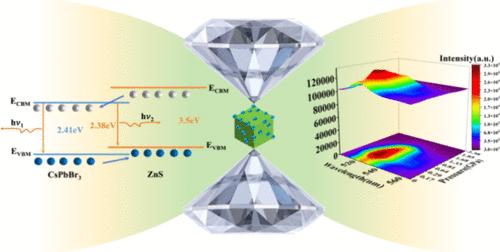当前位置:
X-MOL 学术
›
J. Phys. Chem. C
›
论文详情
Our official English website, www.x-mol.net, welcomes your
feedback! (Note: you will need to create a separate account there.)
Pressure Effect on Luminescence Characteristics and Energy Transfer in CsPbBr3/ZnS Nanocrystal Heterostructures
The Journal of Physical Chemistry C ( IF 3.3 ) Pub Date : 2024-11-15 , DOI: 10.1021/acs.jpcc.4c06610
Zexun Cui 1 , Pingping Zhang 2 , Weixin Li 1 , Pengyu Zhou 1 , Yu Zhang 1 , Bao Liu 1 , Yuqiang Li 2
The Journal of Physical Chemistry C ( IF 3.3 ) Pub Date : 2024-11-15 , DOI: 10.1021/acs.jpcc.4c06610
Zexun Cui 1 , Pingping Zhang 2 , Weixin Li 1 , Pengyu Zhou 1 , Yu Zhang 1 , Bao Liu 1 , Yuqiang Li 2
Affiliation

|
All-inorganic perovskite CsPbX3 (X = Cl, Br, or I) and related materials have shown great potential for applications in solar cells, light-emitting diodes, and photodetectors. A kind of heterostructure was proposed comprising CsPbBr3/ZnS nanocrystals in order to enhance the luminescence properties of CsPbBr3 nanocrystals. The incorporation of ZnS induces recombination at the interface, facilitating charge transfer and the formation of a type-II heterostructure. The luminescence characteristics of this heterostructure can be modulated by applying pressure. The photoluminescence intensity of the CsPbBr3/ZnS nanocrystals is significantly enhanced up to 0.29 GPa. With further pressure increase, these nanocrystals exhibit a red shift in emission wavelength, resulting in a high sensitivity (dλ/dP) of 9.59 nm GPa–1 and an absolute sensitivity (dFWHM/dP) of 6.07 nm GPa–1. Photoluminescence quenching occurs until the completely undetectable emission at a pressure of 2.38 GPa. The observed anomalous enhancement and wavelength red shift indicate that pressure can promote the transition from free excitons to self-trapping excitons, leading to energy transfer between ZnS and CsPbBr3. This study enhances the understanding effect of high pressure on luminescent materials in heterostructures.
中文翻译:

压力对 CsPbBr3/ZnS 纳米晶异质结构中发光特性和能量传递的影响
全无机钙钛矿 CsPbX3(X = Cl、Br 或 I)和相关材料在太阳能电池、发光二极管和光电探测器中显示出巨大的应用潜力。为了增强 CsPbBr3 纳米晶的发光性能,提出了一种包含 CsPbBr3/ZnS 纳米晶的异质结构。ZnS 的掺入在界面处诱导复合,促进电荷转移和 II 型异质结构的形成。这种异质结构的发光特性可以通过施加压力来调节。CsPbBr3/ZnS 纳米晶体的光致发光强度显著提高,最高可达 0.29 GPa。随着压力的进一步升高,这些纳米晶体在发射波长上表现出红移,导致高灵敏度 (dλ/dP) 为 9.59 nm GPa–1 和绝对灵敏度 (dFWHM/dP) 为 6.07 nm GPa–1。光致发光猝灭发生,直到在 2.38 GPa 的压力下完全无法检测到发射。观察到的异常增强和波长红移表明,压力可以促进从自由激子到自捕获激子的转变,从而导致 ZnS 和 CsPbBr3 之间的能量转移。本研究增强了对异质结构中高压发光材料的理解效果。
更新日期:2024-11-15
中文翻译:

压力对 CsPbBr3/ZnS 纳米晶异质结构中发光特性和能量传递的影响
全无机钙钛矿 CsPbX3(X = Cl、Br 或 I)和相关材料在太阳能电池、发光二极管和光电探测器中显示出巨大的应用潜力。为了增强 CsPbBr3 纳米晶的发光性能,提出了一种包含 CsPbBr3/ZnS 纳米晶的异质结构。ZnS 的掺入在界面处诱导复合,促进电荷转移和 II 型异质结构的形成。这种异质结构的发光特性可以通过施加压力来调节。CsPbBr3/ZnS 纳米晶体的光致发光强度显著提高,最高可达 0.29 GPa。随着压力的进一步升高,这些纳米晶体在发射波长上表现出红移,导致高灵敏度 (dλ/dP) 为 9.59 nm GPa–1 和绝对灵敏度 (dFWHM/dP) 为 6.07 nm GPa–1。光致发光猝灭发生,直到在 2.38 GPa 的压力下完全无法检测到发射。观察到的异常增强和波长红移表明,压力可以促进从自由激子到自捕获激子的转变,从而导致 ZnS 和 CsPbBr3 之间的能量转移。本研究增强了对异质结构中高压发光材料的理解效果。




































 京公网安备 11010802027423号
京公网安备 11010802027423号